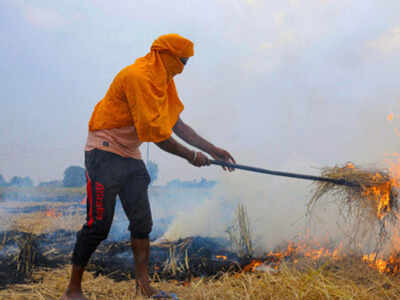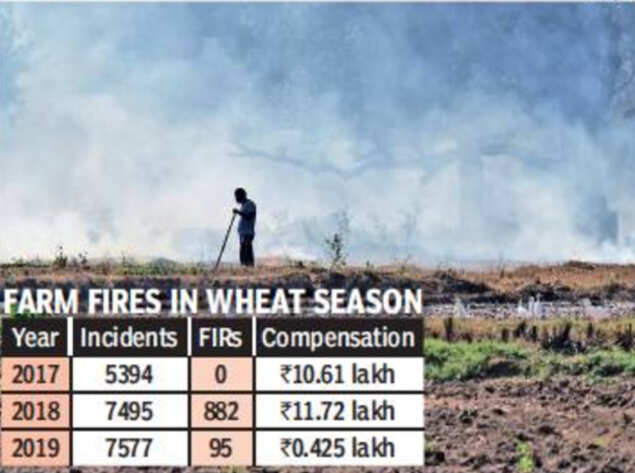
CHANDIGARH: With the beginning of wheat harvesting season in Haryana, the state authorities have also started the process to contain stubble burning, as burning of paddy residue had become a major source of air pollution last year.
The incidents of wheat stubble burning is being monitored by Haryana Space Application Centre (HARSAC) and other district-level committees, comprising officials from the agriculture and revenue departments.

During the 2019 wheat season, the state had witnessed around 7,500 incidents of stubble burning, for which around 95 FIRs were registered by the authorities against the erring farmers. During the wheat harvesting season, maximum instances of stubble burning take place in Karnal, Sonepat, Jind, Panipat and Kaithal districts.
Talking to TOI, S Narayanan, member-secretary, Haryana State Pollution Control Board (HSPCB), said they have already issued advertisements/ radio jingles requesting the farmers to not burn stubble. HSPCB is the controlling authority of stubble burning, along with the agriculture department.
“We are also going to monitor the active fire locations through HARSAC and share the same to all officers concerned as we have been doing every year,” Narayanan added.
HARSAC, which comes under the state’s science and technology department, uses satellite images to locate stubble burning spots in the state during harvesting seasons. On receiving the images, it sends messages to the district administrations concerned, sharing the location of the area. Thereafter, the district administration takes action against the erring farmers. During the paddy season last year, several punitive actions were taken by the district administrations, which had resulted in fewer instances of stubble burning in the state.
According to experts, the stubble burning of wheat crop is not a serious issue as compared to the burning of paddy during winters, because the residue of wheat is high in demand, for it is largely used for fodder. Wheat residue is purchased from farmers either by local residents in the village or by those into selling fodder. Farmers themselves also store fodder prepared from wheat residue for the consumption of their livestock.
According to information provided by HSPCB in response to an RTI petition, a total of 5,394 cases of wheat stubble burning were reported in 2017, around 7,400 in 2018 and a similar number in 2019.
The incidents of wheat stubble burning is being monitored by Haryana Space Application Centre (HARSAC) and other district-level committees, comprising officials from the agriculture and revenue departments.

During the 2019 wheat season, the state had witnessed around 7,500 incidents of stubble burning, for which around 95 FIRs were registered by the authorities against the erring farmers. During the wheat harvesting season, maximum instances of stubble burning take place in Karnal, Sonepat, Jind, Panipat and Kaithal districts.
Talking to TOI, S Narayanan, member-secretary, Haryana State Pollution Control Board (HSPCB), said they have already issued advertisements/ radio jingles requesting the farmers to not burn stubble. HSPCB is the controlling authority of stubble burning, along with the agriculture department.
“We are also going to monitor the active fire locations through HARSAC and share the same to all officers concerned as we have been doing every year,” Narayanan added.
HARSAC, which comes under the state’s science and technology department, uses satellite images to locate stubble burning spots in the state during harvesting seasons. On receiving the images, it sends messages to the district administrations concerned, sharing the location of the area. Thereafter, the district administration takes action against the erring farmers. During the paddy season last year, several punitive actions were taken by the district administrations, which had resulted in fewer instances of stubble burning in the state.
According to experts, the stubble burning of wheat crop is not a serious issue as compared to the burning of paddy during winters, because the residue of wheat is high in demand, for it is largely used for fodder. Wheat residue is purchased from farmers either by local residents in the village or by those into selling fodder. Farmers themselves also store fodder prepared from wheat residue for the consumption of their livestock.
According to information provided by HSPCB in response to an RTI petition, a total of 5,394 cases of wheat stubble burning were reported in 2017, around 7,400 in 2018 and a similar number in 2019.

Coronavirus outbreak
Trending Topics
LATEST VIDEOS
City
 Watch: 'Yamraj' walks around streets in Bihar’s Munger to remind people about Covid-19 danger
Watch: 'Yamraj' walks around streets in Bihar’s Munger to remind people about Covid-19 danger  Moradabad stone-pelting: Injured doctor narrates horrific incident
Moradabad stone-pelting: Injured doctor narrates horrific incident  Covid-19: Accused in Bandra migrant gathering sent to police custody till April 21
Covid-19: Accused in Bandra migrant gathering sent to police custody till April 21  Watch: Jammu witnesses traffic jam despite extension of lockdown
Watch: Jammu witnesses traffic jam despite extension of lockdown
More from TOI
Navbharat Times
Featured Today in Travel
Quick Links
Kerala Coronavirus Helpline NumberHaryana Coronavirus Helpline NumberUP Coronavirus Helpline NumberBareilly NewsBhopal NewsCoronavirus in DelhiCoronavirus in HyderabadCoronavirus in IndiaCoronavirus symptomsCoronavirusRajasthan Coronavirus Helpline NumberAditya ThackerayShiv SenaFire in MumbaiAP Coronavirus Helpline NumberArvind KejriwalJammu Kashmir Coronavirus Helpline NumberSrinagar encounter
Get the app





